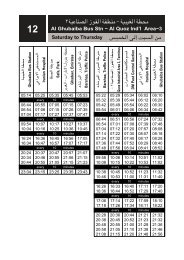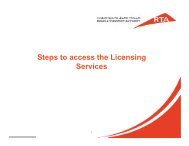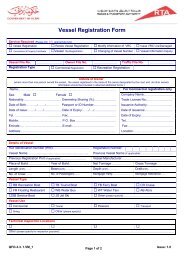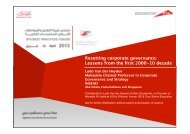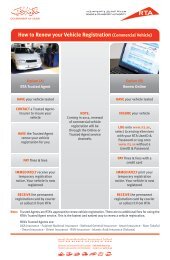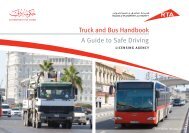Shovel Operator's Handbook A Guide to Safe Operation
Shovel Operator's Handbook A Guide to Safe Operation
Shovel Operator's Handbook A Guide to Safe Operation
Create successful ePaper yourself
Turn your PDF publications into a flip-book with our unique Google optimized e-Paper software.
<strong>Shovel</strong> Opera<strong>to</strong>r’s <strong>Handbook</strong><br />
A <strong>Guide</strong> <strong>to</strong> <strong>Safe</strong> <strong>Operation</strong><br />
<strong>Shovel</strong> Opera<strong>to</strong>r’s <strong>Handbook</strong><br />
A <strong>Guide</strong> <strong>to</strong> <strong>Safe</strong> <strong>Operation</strong><br />
LICENSING AGENCY<br />
1st Edition November 2008
<strong>Shovel</strong> <strong>Handbook</strong> A <strong>Guide</strong> <strong>to</strong> SAfe oPeRAtioN
Table of Contents<br />
introduction 5<br />
What this <strong>Handbook</strong> is About 5<br />
Why Read this <strong>Handbook</strong> 5<br />
How <strong>to</strong> use this <strong>Handbook</strong> 5<br />
How You Will Learn 6<br />
Symbols 7<br />
Part 1: Licence <strong>to</strong> operate a <strong>Shovel</strong> 9<br />
eligibility Criteria 9<br />
Learning <strong>to</strong> operate a <strong>Shovel</strong> 9<br />
1
<strong>Shovel</strong> <strong>Handbook</strong> A <strong>Guide</strong> <strong>to</strong> SAfe oPeRAtioN<br />
Part 2: types and Components of <strong>Shovel</strong>s 13<br />
2<br />
What is a <strong>Shovel</strong>? 13<br />
types of <strong>Shovel</strong>s 14<br />
Components of <strong>Shovel</strong>s 15<br />
<strong>Shovel</strong> Controls 16<br />
Bucket Controls 17<br />
Pedals 18<br />
Part 3: <strong>Shovel</strong> <strong>Safe</strong>ty 21<br />
Learning operating and Handling Skills 21<br />
Work Site <strong>Safe</strong>ty 22<br />
external Vehicle Pre-operational Checks 23<br />
internal Pre-operational Checks 34<br />
Start-up and Shut-down Procedures 35<br />
Shut-down Procedure 38<br />
Refueling 39
Contents<br />
<strong>Shovel</strong> emergency Procedures 40<br />
Part 4: <strong>Shovel</strong> operation 40<br />
Planning <strong>to</strong> Work 45<br />
filling the Bucket 46<br />
filling the Bucket from a S<strong>to</strong>ckpile 47<br />
<strong>to</strong> fill a Bucket When digging and Loading on Level Ground 48<br />
transporting with a full Bucket 49<br />
Loading a truck 50<br />
Levelling and Pushing operations 51<br />
travelling on Sloping Ground 52<br />
Part 5: fitting and Removal of Attachments 55<br />
front Attachments 55<br />
Rear Attachments 58<br />
How <strong>to</strong> fit, operate and Remove Common Attachments 59<br />
3
<strong>Shovel</strong> <strong>Handbook</strong> A <strong>Guide</strong> <strong>to</strong> SAfe oPeRAtioN<br />
4
Introduction<br />
What this <strong>Handbook</strong> is About<br />
this handbook is about the skills and knowledge required <strong>to</strong> safely operate a shovel. the handbook is for<br />
a shovel with an empty weight exceeding 7.5 <strong>to</strong>nnes.<br />
Why Read this <strong>Handbook</strong><br />
this handbook tells you about some of the legal requirements for shovel opera<strong>to</strong>rs in dubai, along with<br />
important safety information, background material, technical information and current procedures.<br />
the knowledge test that you must pass <strong>to</strong> get a shovel licence is based on the material in this<br />
handbook. You need <strong>to</strong> understand the information in this handbook <strong>to</strong> pass your test.<br />
How <strong>to</strong> use this <strong>Handbook</strong><br />
the table of Contents will show you where <strong>to</strong> find each section. At the end of each section,<br />
there is a section called test Yourself Questions <strong>to</strong> help you check if you have unders<strong>to</strong>od<br />
important issues.<br />
5
<strong>Shovel</strong> <strong>Handbook</strong> A <strong>Guide</strong> <strong>to</strong> SAfe oPeRAtioN<br />
How You Will Learn<br />
Learning <strong>to</strong> operate a shovel is like any other complex task. if you break the task in<strong>to</strong> small, manageable pieces and do not try <strong>to</strong><br />
learn <strong>to</strong>o many things at once, it is much easier. You will:<br />
•<br />
•<br />
•<br />
6<br />
develop the knowledge and skills needed <strong>to</strong> operate forklifts<br />
be shown how <strong>to</strong> drive and control forklifts safely<br />
practise and correct your driving techniques in an increasingly complex set of conditions, so that you are capable of successfully<br />
undertaking your licence test.<br />
the length of each stage of learning depends on the amount of practice you have had. Be sure you are confident and competent<br />
before moving on <strong>to</strong> the next stage. Your instruc<strong>to</strong>r will advise you when you are ready <strong>to</strong> move on.<br />
How fast and how much you learn will depend on you. You should learn by:<br />
•<br />
•<br />
•<br />
•<br />
•<br />
•<br />
reading this handbook carefully<br />
attempting all the questions and activities in the handbook<br />
observing the operations being performed by your instruc<strong>to</strong>r and on your work site<br />
asking questions<br />
practising the new skills included in this handbook<br />
undertaking the assessment tasks on completion of the training.<br />
if there is anything in this handbook you do not understand or do not agree with, do not be afraid <strong>to</strong> ask your instruc<strong>to</strong>r for<br />
assistance.
introduction<br />
Symbols<br />
Symbols used in the handbook.<br />
Graphic symbols are used <strong>to</strong> guide your learning and identify types of information. the meaning<br />
of each symbol is as follows:<br />
?<br />
Caution You must follow instructions <strong>to</strong> avoid damage <strong>to</strong> products, a process or<br />
surroundings.<br />
<strong>Safe</strong>ty You must follow safety procedures or wear protective clothing.<br />
Test Yourself Questions Check that you have unders<strong>to</strong>od the information in this section by<br />
answering the questions at the end of each section.<br />
7
<strong>Shovel</strong> <strong>Handbook</strong> A <strong>Guide</strong> <strong>to</strong> SAfe oPeRAtioN<br />
8
Part 1: Licence <strong>to</strong> Operate a <strong>Shovel</strong><br />
eligibility Criteria<br />
the eligibility criteria for a licence <strong>to</strong> operate a shovel are set out below.<br />
You may drive a shovel if you:<br />
• are over 20 years of age<br />
• have passed an eye test<br />
• have undertaken shovel opera<strong>to</strong>r training until competency is shown<br />
• have passed a practical test<br />
• pay the agreed fees.<br />
if you meet these criteria, you will be issued with a Heavy trac<strong>to</strong>r and Mechanical equipment<br />
licence.<br />
Learning <strong>to</strong> operate a <strong>Shovel</strong><br />
until you get your shovel licence, you may only drive a shovel if you are under the supervision<br />
of an instruc<strong>to</strong>r who holds a valid licence for the type of vehicle you are driving.<br />
9
<strong>Shovel</strong> <strong>Handbook</strong> A <strong>Guide</strong> <strong>to</strong> SAfe oPeRAtioN<br />
10<br />
?<br />
test Yourself Questions<br />
Q1 What age do you have <strong>to</strong> be <strong>to</strong> apply for your shovel licence?<br />
Q2 What tests do you need <strong>to</strong> pass <strong>to</strong> obtain your shovel licence?<br />
AQ1 You must be over 20 years of age<br />
AQ2 Yes, a knowledge test and a practical test
Part 1: Licence <strong>to</strong> operate a <strong>Shovel</strong><br />
11
<strong>Shovel</strong> <strong>Handbook</strong> A <strong>Guide</strong> <strong>to</strong> SAfe oPeRAtioN<br />
12
Part 2 : Types and Components of <strong>Shovel</strong>s<br />
What is a <strong>Shovel</strong>?<br />
A shovel is also known as a front-end loader, loader, a bucket loader or sometimes a scoop loader. it is<br />
a bucket that is on the end of movable arms. it tilts and is used <strong>to</strong> lift and move material. the shovel is<br />
part of a trac<strong>to</strong>r. it is either a permanent-mounted version or a removable attachment. the bucket at the<br />
end of the arms can be replaced with other <strong>to</strong>ols, such as forks for lifting pallets or bale <strong>to</strong>ols that are<br />
specifically designed <strong>to</strong> handle bales of hay.<br />
<strong>Shovel</strong>s are used for:<br />
• digging operations<br />
• levelling operations<br />
• pushing operations<br />
• load and carry operations<br />
• handling loads similar <strong>to</strong> crane<br />
• mounting other equipment and acting as a <strong>to</strong>ol carrier<br />
• preparing and levelling s<strong>to</strong>ck s<strong>to</strong>rage pads<br />
• <strong>to</strong>wing loads and other equipment similar <strong>to</strong> a trac<strong>to</strong>r<br />
• general clean up of work areas.<br />
13
<strong>Shovel</strong> <strong>Handbook</strong> A <strong>Guide</strong> <strong>to</strong> SAfe oPeRAtioN<br />
types of <strong>Shovel</strong>s<br />
there are many makes and models of shovels. You must locate the opera<strong>to</strong>r’s manual for your shovel and study the operating and<br />
safety features. You will find that the position and operation of the controls vary considerably.<br />
Before starting or operating your shovel:<br />
•<br />
•<br />
•<br />
14<br />
locate and identify each control and familiarise yourself with its function<br />
check the position and operation of park brakes and emergency devices<br />
know how <strong>to</strong> s<strong>to</strong>p the engine.<br />
Some shovels are tracked machines. the tracks allow them access <strong>to</strong> rougher working areas that would damage tyres.<br />
Larger shovels have a steering feature known as articulated steering. they steer from a pivot point set between the front and rear<br />
axles. this allows the front axle <strong>to</strong> be solid and support more weight. the driver can steer the loaded bucket in a tight arch <strong>to</strong> reach<br />
a truck. there is danger of tipping over, because the weight is shifted away from the body of the shovel.
Part 2: types and Components of <strong>Shovel</strong>s<br />
Components of <strong>Shovel</strong>s<br />
15
<strong>Shovel</strong> <strong>Handbook</strong> A <strong>Guide</strong> <strong>to</strong> SAfe oPeRAtioN<br />
<strong>Shovel</strong> Controls<br />
there are a number of pedals and levers <strong>to</strong> operate. Various combinations will be used at the same time, depending on what work<br />
you will be doing. Check the opera<strong>to</strong>r’s manual for your shovel for details of position and operation.<br />
Typical controls<br />
1. transmission gear selection lever<br />
2. forward and reverse shift lever<br />
3. Park brake switch<br />
4. <strong>Safe</strong>ty lock lever<br />
5. Bucket control lever<br />
6. Lift control lever with transmission kick down switch<br />
7. Brake pedals<br />
8. Accelera<strong>to</strong>r.<br />
As well as the control levers and pedals, shovels have alarms<br />
and gauges <strong>to</strong> help you check the condition of the shovel.<br />
Alarms let you know when the shovel is not operating properly<br />
or when there is a danger.<br />
16<br />
Never continue <strong>to</strong> use a shovel when an alarm is sounding and never disconnect or tamper<br />
with any warning system<br />
1<br />
3<br />
2<br />
7 8<br />
5<br />
6<br />
4
Part 2: types and Components of <strong>Shovel</strong>s<br />
Bucket Controls<br />
the controls <strong>to</strong> lift the bucket are: 1. Raise 2. Hold 3. Lower 4. float<br />
4<br />
the controls <strong>to</strong> tip the bucket are: 1. Roll back, crowd or tilt 2. Hold 3. tip or dump<br />
3<br />
3<br />
2<br />
2<br />
1<br />
1<br />
RAISE<br />
LOWER<br />
DUMP<br />
Make sure you make the raised bucket safe by using chocks, blocks or safety bars<br />
before you inspect underneath it.<br />
TILT<br />
17
<strong>Shovel</strong> <strong>Handbook</strong> A <strong>Guide</strong> <strong>to</strong> SAfe oPeRAtioN<br />
Pedals<br />
Right pedal – service brake, normal braking operations when<br />
travelling.<br />
Left pedal – applies the brake and neutralises the<br />
transmission <strong>to</strong> allow the engine revs <strong>to</strong> be increased, which<br />
is used <strong>to</strong> increase the hydraulics speed.<br />
Park Brake <strong>Operation</strong><br />
the park brake should be able <strong>to</strong> hold the trac<strong>to</strong>r when fully<br />
loaded <strong>to</strong> the manufacturer’s maximum permissible trac<strong>to</strong>r<br />
weight, including any ballast, equipment and material load.<br />
Headlights, Turning Indica<strong>to</strong>rs and Windscreen<br />
Wipers<br />
You will need <strong>to</strong> look at the opera<strong>to</strong>r’s manual for your<br />
shovel <strong>to</strong> locate the switches for operating the headlights,<br />
indica<strong>to</strong>rs and windscreen wipers.<br />
When you understand the uses of a shovel, its parts and the alarms and controls, you are ready <strong>to</strong> proceed <strong>to</strong> the next section.<br />
18
Part 2: types and Components of <strong>Shovel</strong>s<br />
?<br />
test Yourself Questions<br />
Q1 Name four typical controls on a shovel.<br />
Q2 Name five operations shovels are used for.<br />
Q3 What should you do before inspecting underneath a bucket?<br />
Q4 What are alarms on a shovel used for?<br />
Q5 Large shovels have special steering that lets the driver steer a loaded bucket in a<br />
tight arch <strong>to</strong> reach a truck. What is it called?<br />
AQ1 Transmission gear selection lever, Forward and reverse shift lever, Park brake switch, <strong>Safe</strong>ty lock lever, Bucket control lever, Lift<br />
control lever with transmission kick down switch, Brake pedals<br />
AQ2 Digging operations. Levelling operations. Pushing operations. Load and carry operations.<br />
Handling loads similar <strong>to</strong> crane. Mounting other equipment and acting as a <strong>to</strong>ol carrier. Preparing and levelling s<strong>to</strong>ck s<strong>to</strong>rage pads.<br />
Towing loads and other equipment similar <strong>to</strong> a trac<strong>to</strong>r. General clean up of work areas.<br />
AQ3 Make sure you have made the raised bucket safe by using chocks, blocks or safety bars <strong>to</strong> secure it.<br />
AQ4 To let you know when the shovel is not operating properly or when there is a danger.<br />
AQ5 It is called articulated steering.<br />
19
<strong>Shovel</strong> <strong>Handbook</strong> A <strong>Guide</strong> <strong>to</strong> SAfe oPeRAtioN<br />
20
Part 3: <strong>Shovel</strong> <strong>Safe</strong>ty<br />
Learning operating and Handling Skills<br />
Your instruc<strong>to</strong>r will demonstrate a wide range of driving and handling skills and then get you <strong>to</strong> practice<br />
activities within the work area whilst he supervises from within the cabin. these activities will include:<br />
• making sure that the worksite is safe<br />
• locating and understanding the various controls and alarms within the cabin<br />
• starting the shovel<br />
• moving forward and reversing the shovel<br />
• driving around obstacles<br />
• loading, carrying and unloading the bucket<br />
• unloading in<strong>to</strong> a dump truck<br />
• spreading a load and levelling operations<br />
• s<strong>to</strong>pping and shutting down the shovel.<br />
While you are practising, your instruc<strong>to</strong>r will provide helpful feedback.<br />
Your safety and the safety of others depends upon your care and<br />
judgement in the operation of the shovel.<br />
21
<strong>Shovel</strong> <strong>Handbook</strong> A <strong>Guide</strong> <strong>to</strong> SAfe oPeRAtioN<br />
Work Site <strong>Safe</strong>ty<br />
follow all these safety rules, precautions and instructions when operating or performing maintenance on the shovel.<br />
•<br />
•<br />
•<br />
•<br />
•<br />
•<br />
•<br />
22<br />
do not operate the shovel if you are not feeling well, or if you are taking medicine which will make you sleepy, or if you have been<br />
drinking alcohol.<br />
When working with another driver or with a person on work site traffic duty, be sure that all personnel understand all hand<br />
signals that are <strong>to</strong> be used.<br />
Always follow all work site rules related <strong>to</strong> safety.<br />
Be sure all guards and covers are in their proper position and have them repaired if damaged.<br />
Avoid loose clothing and jewellery, and loose, long hair. they can catch on controls or in moving parts and cause serious injury or<br />
death.<br />
do not wear oily clothes, because they are flammable. Wear a hard hat, safety glasses, safety shoes, mask or gloves when<br />
operating or maintaining the shovel. in dusty or hazardous areas you may need <strong>to</strong> wear a mask or other breathing protection.<br />
Check that there is no one near the shovel before commencing operations.
Part 3: <strong>Shovel</strong> <strong>Safe</strong>ty<br />
external Vehicle Pre-operational Checks<br />
Carry out the following checks before starting the engine at the beginning of the day’s work.<br />
failure <strong>to</strong> carry out these checks may lead <strong>to</strong> serious injury or damage.<br />
<strong>Safe</strong>ty decals and shovel<br />
specifications<br />
<strong>Safe</strong>ty decals are signs that are used <strong>to</strong><br />
indicate:<br />
•<br />
•<br />
•<br />
general safety rules<br />
potentially hazardous situations<br />
immediate hazards which could cause<br />
death or serious injury.<br />
Check that you have read all safety decals and<br />
specification plates. You will need <strong>to</strong> refer <strong>to</strong><br />
these <strong>to</strong> check and operate equipment.<br />
23
<strong>Shovel</strong> <strong>Handbook</strong> A <strong>Guide</strong> <strong>to</strong> SAfe oPeRAtioN<br />
Specifications are used <strong>to</strong> indicate levels of operation. for example, a bolt that has been<br />
tightened beyond recommended <strong>to</strong>rque specifications can easily break in use and can also<br />
cause danger <strong>to</strong> the opera<strong>to</strong>r. tyre pressure specifications will show the maximum pressure<br />
for a tyre.<br />
Tyres and Wheels<br />
tyres are very expensive items in shovel operations and are often overlooked during daily<br />
checks. tyre pressure should be checked regularly while the tyres are cold. When adding air<br />
<strong>to</strong> the tyre, it is a good safety idea <strong>to</strong> stand <strong>to</strong> one side of the wheel. tyres have been known<br />
<strong>to</strong> fly off the rim.<br />
Check that tyre pressures are within specifications and of equal pressure. Adjust as necessary.<br />
When checking the air pressure of water filled tyres, make sure the valve is at the <strong>to</strong>p of the<br />
wheel.<br />
24<br />
Uneven tyre pressure will cause the load <strong>to</strong><br />
transfer <strong>to</strong> the side with the lower pressure and<br />
may cause an overturn.<br />
Check that all wheel nuts are tight – that there is no looseness<br />
and tighten if required.<br />
Visually check the tyre case for cuts and gouges, s<strong>to</strong>nes, wire<br />
or metal embedded in the rubber. Report any damage <strong>to</strong> your<br />
supervisor.
Part 3: <strong>Shovel</strong> <strong>Safe</strong>ty<br />
Wheel Changing<br />
depending on your company policy, it may be necessary <strong>to</strong> remove and replace a wheel on<br />
your shovel.<br />
•<br />
•<br />
•<br />
•<br />
•<br />
•<br />
•<br />
ensure that the shovel is in a safe position for jacking. Before positioning the jack, check that<br />
the shovel braking systems are engaged.<br />
Always block the wheels on the opposite side of the shovel.<br />
Position the jack on a base plate and in a safe lifting position.<br />
Loosen the wheel nuts before lifting the shovel.<br />
Lift the shovel so that the wheel is clear of the ground.<br />
Support the shovel on a suitable stand or wooden blocks <strong>to</strong> prevent it from falling from the jack.<br />
Remove the wheel nuts, then the wheel.<br />
A shovel wheel with ballast will weigh many kilograms. it may take two people <strong>to</strong> manually remove the wheel or<br />
the use of a mechanical lifting device.<br />
Removing the tyre and tube from the rim is a specialist job. there are several<br />
types of rims in use on shovels. You must check the opera<strong>to</strong>r’s manual for<br />
your shovel for the recommended method of removing tyres from rims for your<br />
shovel.<br />
Newly fitted tyres and tubes with a demountable split rim should be inflated in<br />
a special safety cage, because the rim can fly off if you are not careful.<br />
Replace the wheel using the reverse procedure.<br />
take care when lowering the shovel that it does not slip off the jack. When the<br />
shovel is fully lowered, tighten the wheel nuts.<br />
25
<strong>Shovel</strong> <strong>Handbook</strong> A <strong>Guide</strong> <strong>to</strong> SAfe oPeRAtioN<br />
Lubrication and Hydraulic Systems<br />
Check for leaks and have any leaks repaired. Check around the engine, all hydraulic cylinders and hoses, under the shovel engine,<br />
transmission and oil cooler. Adjust levels <strong>to</strong> manufacturer’s specifications, if needed. Check the opera<strong>to</strong>r’s manual for your shovel<br />
for details of lubrication that is required before each use.<br />
Fuel System<br />
fuel levels may be checked by fuel gauge, dip stick, sight gauge or mobile warning device.<br />
Before removing the fuel cap, clean dirt and dust from around the filler <strong>to</strong> prevent contamination.<br />
Add fuel through an acceptable fuel filter <strong>to</strong> the required level. Replace the filler cap when finished.<br />
equipment should be refuelled after use <strong>to</strong> cool the remaining fuel and minimise the intake of moisture from atmosphere<br />
overnight.<br />
Check the breather on the fuel tank. A blocked breather may cause a vacuum in the fuel tank and reduce or s<strong>to</strong>p fuel flow. Clean<br />
the breather at regular intervals.<br />
26<br />
Do not fuel the shovel near any fire or flame.
Part 3: <strong>Shovel</strong> <strong>Safe</strong>ty<br />
Oil Levels - Engine Sump<br />
ensure that the shovel is on level ground and allow engine <strong>to</strong> cool.<br />
•<br />
•<br />
•<br />
•<br />
Remove the dipstick and wipe clean with a cloth.<br />
Replace the dipstick fully in<strong>to</strong> the hole.<br />
Remove the dipstick and check the oil level.<br />
Add oil <strong>to</strong> the correct level if found <strong>to</strong> be insufficient. Make sure that the oil is of the correct type.<br />
Hydraulic Oil Level Reservoir<br />
•<br />
•<br />
•<br />
oil level may be checked by dipstick or sight gauge.<br />
if checking by dipstick, use the same method as checking for engine sump oil levels.<br />
Add oil <strong>to</strong> the correct level if found <strong>to</strong> be insufficient. Make sure that the oil is of the correct type.<br />
Use a piece of cardboard or wood, rather than hands, and wear eye protection when searching for<br />
hydraulic leaks.<br />
escaping hydraulic oil under pressure can penetrate skin. if oil is injected in<strong>to</strong> skin, it must be surgically removed within a<br />
few hours by a doc<strong>to</strong>r or gangrene may result.<br />
27
<strong>Shovel</strong> <strong>Handbook</strong> A <strong>Guide</strong> <strong>to</strong> SAfe oPeRAtioN<br />
Engine Coolant Level<br />
if the engine has been running, remove the radia<strong>to</strong>r cap with caution <strong>to</strong><br />
avoid serious burns.<br />
Modern engines use recovery cooling systems. this system has a small<br />
external container or bottle attached <strong>to</strong> the radia<strong>to</strong>r overflow tube which<br />
s<strong>to</strong>res coolant. this is forced out during operation due <strong>to</strong> expansion.<br />
Some of the contents of the recovery bottle are drawn back in<strong>to</strong> the<br />
radia<strong>to</strong>r as the engine cools after shut-down.<br />
Oil Level - Transmission and Differential Case<br />
• transmission and differential case oil levels are best checked when the shovel is parked and it has cooled down.<br />
• the cases may have a dipstick, sight glass, level plug or filler plug requiring removal <strong>to</strong> indicate the oil level.<br />
• Add the correct oil through the filler plug <strong>to</strong> the required level.<br />
Wipe up any excess oil, fuel or other flammable fluids. Return all fuel containers <strong>to</strong> their proper place.<br />
28<br />
FULL<br />
LOW<br />
1 1
Part 3: <strong>Shovel</strong> <strong>Safe</strong>ty<br />
Air Filters and Air Intake<br />
Air cleaner systems also need regular maintenance. the most common sign that the air<br />
cleaner system needs attention is that the indica<strong>to</strong>r will change colour or the gauge will show<br />
in<strong>to</strong> the red, or an alarm could sound, depending on the system. Check for clogging of the air<br />
cleaner. Check all tubing, hoses and clamps for security and sealing. Check your opera<strong>to</strong>r manual<br />
for the air cleaner warning system on your shovel. Some air cleaner elements can be cleaned and<br />
reused and some will need replacing.<br />
1. Raw air intake area<br />
2. intake manifold pressure seal<br />
3. Air cleaner restriction indica<strong>to</strong>r<br />
4. Low pressure (super charger) manifold<br />
5. Air cleaner<br />
6. Clean air tube<br />
7. Hump hose clamps<br />
8. Hump hoses<br />
9. Supercharger intake seal<br />
10. trunking support bracket<br />
11. High pressure air seal<br />
12. Super charger<br />
5<br />
13<br />
1<br />
4<br />
6<br />
7<br />
8<br />
3<br />
2<br />
9<br />
10<br />
11<br />
12<br />
29
<strong>Shovel</strong> <strong>Handbook</strong> A <strong>Guide</strong> <strong>to</strong> SAfe oPeRAtioN<br />
Fan Belts<br />
You will need <strong>to</strong> check the tension of the belt by depressing between the fan and the alterna<strong>to</strong>r pulleys.<br />
Electrical wiring<br />
Check for damage <strong>to</strong> the electric wiring. use the opera<strong>to</strong>r’s manual for your shovel <strong>to</strong> locate the wiring layout for the shovel you<br />
are using. You should check for frayed or broken wires, and that lights and horn are working.<br />
30<br />
FAN PULLEY<br />
CRANKSHAFT PULLEY<br />
APPROX. 75mm<br />
(0.3in)<br />
ALTERNATOR<br />
PULLEY
Part 3: <strong>Shovel</strong> <strong>Safe</strong>ty<br />
Battery Condition<br />
Checking the battery regularly is an important task. Most shovel starting problems are the<br />
result of poor battery maintenance. Check the battery for:<br />
•<br />
•<br />
•<br />
•<br />
•<br />
Correct electrolyte level; low level can cause the battery <strong>to</strong> over-heat and fail prematurely; high<br />
levels can overflow when being recharged, causing corrosion.<br />
tight terminals ensure a good connection during starting operations.<br />
Loose terminals can cause a spark, which in turn can cause an explosion.<br />
Residue build-up on the terminals can cause charge leakage, the terminals <strong>to</strong> become corroded and<br />
the area around the battery <strong>to</strong> be damaged. Clean off by flushing with water and then coat the clean<br />
terminals with a commercial anti-corrosion paste or heavy grease.<br />
the battery is securely restrained. Working over rough ground may cause the battery <strong>to</strong> jump around and<br />
be damaged.<br />
Mirrors, Handrails and Steps<br />
Remove any dirt from the mirrors, handrails, and steps. Check handrails and steps for:<br />
•<br />
•<br />
•<br />
•<br />
grease<br />
oil<br />
mud<br />
any other slippery substance.<br />
Adjust the side mirror <strong>to</strong> a position which gives<br />
the best view from the opera<strong>to</strong>r’s seat.<br />
Clean the surface of the mirror. (if the mirror glass<br />
is damaged, replace with a new part.)<br />
31
<strong>Shovel</strong> <strong>Handbook</strong> A <strong>Guide</strong> <strong>to</strong> SAfe oPeRAtioN<br />
Opera<strong>to</strong>r’s Seat<br />
Adjust the opera<strong>to</strong>r’s seat <strong>to</strong> a position where it is easy <strong>to</strong> carry out operations. Check for wear or damage<br />
<strong>to</strong> the seat belt and seat belt mounting equipment.<br />
Gauges<br />
Check that the gauges work properly.<br />
Levers<br />
Check that the control levers are at the PARKiNG position.<br />
32
Part 3: <strong>Shovel</strong> <strong>Safe</strong>ty<br />
Worksite Emergency Procedures<br />
You need <strong>to</strong> know emergency <strong>Safe</strong>ty Procedures for your worksite.<br />
Remember that you will be able <strong>to</strong> deal more safely with an emergency if You<br />
do Not PANiC.<br />
Worksite emergency procedures should inform you of the following:<br />
• the action <strong>to</strong> be taken in an emergency<br />
• who <strong>to</strong> report <strong>to</strong> and where<br />
• emergency phone numbers<br />
• position of emergency s<strong>to</strong>p but<strong>to</strong>ns<br />
• fire extinguishers<br />
• showers<br />
• breathing apparatus<br />
• safe assembly areas and emergency exits<br />
• meaning of horns, sirens, lights and flags, hand signals<br />
• warning signs<br />
• what <strong>to</strong> do in the event of a fire.<br />
33
<strong>Shovel</strong> <strong>Handbook</strong> A <strong>Guide</strong> <strong>to</strong> SAfe oPeRAtioN<br />
internal Pre-operational Checks<br />
You will need <strong>to</strong> know the following internal pre-operation checks.<br />
Correct Entry and Exit Procedure<br />
When getting on or off the shovel, always face the shovel and maintain three-point contact (both<br />
feet and one hand, or both hands and one foot) with the handrails and steps <strong>to</strong> ensure that you<br />
support yourself.<br />
34<br />
Never hold any control levers when getting on or off the shovel.<br />
Always apply the safety lock (if fitted) before leaving the opera<strong>to</strong>rs seat. When standing<br />
up from the opera<strong>to</strong>r’s seat, always place the safety lock lever <strong>to</strong> the LoCK position and<br />
parking brake switch <strong>to</strong> the oN position securely. if you accidentally <strong>to</strong>uch the travel or<br />
swing lever when they are not locked, the shovel may suddenly move and cause serious<br />
injury or damage.<br />
When leaving the shovel, lower the work equipment completely <strong>to</strong> the ground, set the<br />
safety lock lever <strong>to</strong> the LoCK position and the parking brake switch <strong>to</strong> the oN position,<br />
then s<strong>to</strong>p the engine and use the key <strong>to</strong> lock all the equipment. Always take the key<br />
with you.<br />
It is very important <strong>to</strong> use the articulation lock when entering the chassis area between the wheels on an<br />
articulated shovel.<br />
FREE<br />
LOCK
Part 3: <strong>Shovel</strong> <strong>Safe</strong>ty<br />
An articulation lock is used for locking<br />
the pivot connection between the front<br />
and rear frames of an articulated vehicle<br />
for operations such as maintenance and<br />
transporting. the articulation lock has a<br />
number of locking positions. A removable<br />
locking pin is s<strong>to</strong>red next <strong>to</strong> the opera<strong>to</strong>r’s<br />
seat.<br />
Start-up and Shut-down Procedures<br />
You will need <strong>to</strong> check the shovel opera<strong>to</strong>r’s Manual for the correct procedure for starting up and s<strong>to</strong>pping your<br />
shovel.<br />
Before starting the engine:<br />
•<br />
•<br />
•<br />
Walk around your shovel again just before mounting it and check for people and objects that might be in the way.<br />
Know where <strong>to</strong> obtain warning tags.<br />
Never start the engine if a warning tag has<br />
1<br />
been attached <strong>to</strong> a control lever or any other part of the shovel.<br />
Prior <strong>to</strong> starting the engine, sound the horn as<br />
an alert. Start and operate the shovel only<br />
while seated.<br />
LOCK<br />
FREE<br />
DANGER<br />
DO NOT operate<br />
When this plate is not being used<br />
keep it in the s<strong>to</strong>rage compartment.<br />
35
<strong>Shovel</strong> <strong>Handbook</strong> A <strong>Guide</strong> <strong>to</strong> SAfe oPeRAtioN<br />
36<br />
An additional worker should only ride in the shovel when sitting in the<br />
passenger seat. Do not allow anyone <strong>to</strong> ride on the shovel body.<br />
follow this sequence of operations <strong>to</strong> start the shovel:<br />
•<br />
•<br />
•<br />
•<br />
•<br />
•<br />
Check that the park brake is set <strong>to</strong> the engaged position.<br />
Check that the gear selec<strong>to</strong>r is in neutral.<br />
Check that the forward and reverse lever is in neutral and locked (if fitted).<br />
Check that the accelera<strong>to</strong>r pedal is pushed far enough down (past the detent or normal<br />
position) <strong>to</strong> work in with the brake, so that a parking mode is engaged for the shovel while in<br />
a stationary position.<br />
Check that the lift control levers are in the hold position and the control lock is activated (if<br />
fitted).<br />
Before turning the ignition key, sound the horn <strong>to</strong> let other personnel know that you are<br />
about <strong>to</strong> start the engine.<br />
FREE<br />
LOCK<br />
1<br />
1<br />
2 3<br />
4<br />
ON<br />
OFF
Part 3: <strong>Shovel</strong> <strong>Safe</strong>ty<br />
•<br />
•<br />
•<br />
turn the key <strong>to</strong> the start position and hold for a maximum<br />
of 10 seconds or until the engine starts.<br />
When the engine has started, return the key <strong>to</strong> the oN<br />
position.<br />
Check the fuel and oil pressure gauges <strong>to</strong> ensure that they<br />
are working.<br />
Warning:<br />
if the oil pressure gauge does not come up <strong>to</strong><br />
the recommended operating pressure, shut<br />
the engine down immediately and have it<br />
checked before restarting.<br />
if the engine does not start after approximately ten seconds,<br />
allow the starter <strong>to</strong> cool down and try again. if it still will not<br />
run, refer <strong>to</strong> the opera<strong>to</strong>r’s Manual and look under heating<br />
devices for the engine (glow plugs).<br />
once the engine has started, let it warm <strong>to</strong> operating<br />
temperature before it is put under load.<br />
if a turbo charger is fitted, warm up the engine at half the<br />
rated revs per minute (RPM) <strong>to</strong> allow the oil <strong>to</strong> be supplied <strong>to</strong><br />
the turbo charger bearings.<br />
OFF<br />
OFF<br />
ON<br />
ON<br />
START<br />
START<br />
37
<strong>Shovel</strong> <strong>Handbook</strong> A <strong>Guide</strong> <strong>to</strong> SAfe oPeRAtioN<br />
Shut-down Procedure<br />
Shut-down procedures will vary depending upon specific makes and models of shovel. Check the opera<strong>to</strong>r’s Manual for your<br />
shovel.<br />
You will need <strong>to</strong> follow these steps <strong>to</strong> shut down the shovel:<br />
•<br />
•<br />
•<br />
•<br />
•<br />
38<br />
Park on level ground and ensure that the shovel does not obstruct any traffic or access points <strong>to</strong> private property.<br />
Lower all ground engaging implements.<br />
Place the transmission and the forward-reverse levers in<strong>to</strong> neutral (and put locks on).<br />
Place bucket control levers in<strong>to</strong> the neutral position.<br />
Apply the park brake.<br />
idle down the shovel for three <strong>to</strong> five minutes, especially for turbo charge shovels. this procedure allows the components <strong>to</strong> remain<br />
lubricated while the turbine shaft slows down and <strong>to</strong> allow other components <strong>to</strong> cool down.<br />
Before leaving the cab, shut down the engine, remove the keys and relieve pressure in the hydraulic lines by moving the bucket<br />
control levers through all positions.<br />
Before leaving the shovel, walk around it and look for any oil leaks or any damage that may have occurred during operation. Report<br />
any leaks.<br />
if necessary, place a barricade around the shovel <strong>to</strong> make it safe.
Part 3: <strong>Shovel</strong> <strong>Safe</strong>ty<br />
Refuelling<br />
Refuelling at the end of the day will help <strong>to</strong> reduce the amount of condensation in the fuel<br />
tank. Before refuelling:<br />
•<br />
•<br />
•<br />
•<br />
•<br />
Shut down the engine.<br />
Make sure there are no naked flames in the area <strong>to</strong> reduce the risk of fire.<br />
Remove the key, lock the cab and turn off the isola<strong>to</strong>r switch (if fitted).<br />
Before leaving the shovel, walk around it and look for any oil leaks, or any damage that may have<br />
occurred during the day’s activities. Report any problems.<br />
Check all oil levels so that the shovel is ready for the next day’s activities.<br />
39
<strong>Shovel</strong> <strong>Handbook</strong> A <strong>Guide</strong> <strong>to</strong> SAfe oPeRAtioN<br />
40<br />
<strong>Shovel</strong> emergency Procedures<br />
the following is a series of possible emergency situations. the procedure listed is only a guide and may vary with<br />
each individual situation as it develops.<br />
<strong>Shovel</strong> Begins <strong>to</strong> Side Slip on a Grade<br />
•<br />
•<br />
•<br />
immediately dispose of the load.<br />
turn the shovel downhill.<br />
Place the bucket on the ground <strong>to</strong> act as a brake.<br />
<strong>Shovel</strong> Catches On Fire<br />
•<br />
•<br />
•<br />
•<br />
•<br />
S<strong>to</strong>p the shovel.<br />
if possible raise the alarm using the radio.<br />
turn the shovel off.<br />
Get out if possible.<br />
use fire extinguishers if possible.<br />
<strong>Shovel</strong> Contacts Live Power Lines<br />
•<br />
•<br />
•<br />
•<br />
•<br />
do not panic.<br />
Remain inside the cabin.<br />
Warn all other personnel <strong>to</strong> keep clear from the shovel and not <strong>to</strong> <strong>to</strong>uch any part of the machine.<br />
try unaided, and without anyone approaching the shovel, <strong>to</strong> move the shovel until it is clear of the power lines.<br />
if the shovel cannot be moved, remain inside the cabin. if possible, have someone inform the power supply authority and have<br />
the power disconnected. take no action until it has been confirmed by the authority that conditions are safe.
Part 3: <strong>Shovel</strong> <strong>Safe</strong>ty<br />
•<br />
•<br />
if you must leave the shovel’s cabin because of fire or other reasons, take the following<br />
action:<br />
– Jump clear as far as possible from the shovel.<br />
– do not at any time make contact with the shovel and the ground at the same time.<br />
– When moving away from the shovel, the opera<strong>to</strong>r should shuffle or hop slowly away from the<br />
shovel across the ground area that is energised with live power.<br />
– Avoid large steps because one foot could be in a high voltage area and the other foot in a low<br />
voltage area. under some circumstances, the difference between the two could be fatal.<br />
The danger when dismounting is that you may make contact with the “live” truck and the<br />
earth at the same time, causing the power <strong>to</strong> earth through you resulting in death or injury.<br />
Have the shovel checked by a competent person for damage prior <strong>to</strong> further use.<br />
<strong>Shovel</strong> Ruptures a Gas Line<br />
• S<strong>to</strong>p the shovel.<br />
• turn off the machine.<br />
• Leave the shovel.<br />
• Notify the appropriate authorities.<br />
• Keep the area clear of any personnel.<br />
41
<strong>Shovel</strong> <strong>Handbook</strong> A <strong>Guide</strong> <strong>to</strong> SAfe oPeRAtioN<br />
<strong>Shovel</strong> Stalls on Steep Ramp or Road<br />
•<br />
•<br />
•<br />
•<br />
•<br />
•<br />
•<br />
42<br />
Stay inside the cabin.<br />
Apply foot brake or emergency brake.<br />
Bring shovel <strong>to</strong> a s<strong>to</strong>p.<br />
Lower all equipment.<br />
Attempt <strong>to</strong> re-start the engine.<br />
Chock the wheels.<br />
Report the problem and place an out of service tag on the shovel, if required.<br />
<strong>Shovel</strong> Has a Steering Failure<br />
•<br />
•<br />
•<br />
•<br />
•<br />
•<br />
•<br />
Stay inside the cabin.<br />
Apply the foot brake or emergency brake.<br />
Bring the shovel <strong>to</strong> a s<strong>to</strong>p.<br />
Lower all equipment.<br />
Chock the wheels.<br />
Place an out of service tag on the shovel.<br />
Report the problem.<br />
<strong>Shovel</strong> Has Brake Failure on Steep Ramp or Road<br />
•<br />
•<br />
•<br />
•<br />
•<br />
drop the bucket and use it as a brake, if necessary.<br />
Bring the shovel <strong>to</strong> a s<strong>to</strong>p.<br />
Stay inside the cabin.<br />
Apply the emergency brake.<br />
Chock the wheels.
Part 3: <strong>Shovel</strong> <strong>Safe</strong>ty<br />
•<br />
•<br />
Place an out of service tag on the shovel.<br />
Report the problem.<br />
<strong>Shovel</strong> Becomes Hung-up On Edge of S<strong>to</strong>ckpile<br />
•<br />
•<br />
•<br />
Stay inside the cabin.<br />
Apply the park brake or emergency brake.<br />
Call for assistance.<br />
<strong>Shovel</strong> Rolls Over or Partially Rolls on a Slope<br />
•<br />
•<br />
Stay inside the cabin until the shovel s<strong>to</strong>ps.<br />
Call for assistance.<br />
<strong>Shovel</strong> Slips in<strong>to</strong> a Cone or Hole When Pushing Up a S<strong>to</strong>ckpile<br />
•<br />
•<br />
•<br />
•<br />
Stay inside the cabin.<br />
Switch off the mo<strong>to</strong>r.<br />
Call for assistance.<br />
Give your exact location when calling for assistance.<br />
<strong>Shovel</strong> Rolls Over the Edge of a S<strong>to</strong>ckpile<br />
•<br />
•<br />
Stay inside the cabin until the shovel s<strong>to</strong>ps.<br />
Wait for assistance.<br />
43
<strong>Shovel</strong> <strong>Handbook</strong> A <strong>Guide</strong> <strong>to</strong> SAfe oPeRAtioN<br />
44
Part 4: <strong>Shovel</strong> <strong>Operation</strong><br />
Planning <strong>to</strong> Work<br />
it is important <strong>to</strong> have a good knowledge of the work site before commencing operations.<br />
the type of work and material <strong>to</strong> be handled will need <strong>to</strong> be considered when preparing the shovel for<br />
work. Part of your planning operations will include carrying out any safe operating procedures required<br />
at the site.<br />
think about the following points:<br />
• Where is the material <strong>to</strong> be moved <strong>to</strong>?<br />
• Is it <strong>to</strong> be moved only with the shovel?<br />
• Will it be loaded on<strong>to</strong> a haul truck?<br />
• Is it <strong>to</strong> be s<strong>to</strong>ck piled?<br />
• Are you digging it direct from the face or from a s<strong>to</strong>ckpile?<br />
<strong>Safe</strong>ty considerations should include:<br />
• observations of site speed limits<br />
• safe working around overhead power cables<br />
• underground power, water, gas, telephone lines<br />
• overhead conveyors and equipment<br />
• working safely around other shovels and people<br />
• site traffic rules, for example. loaded vehicles, water trucks, etc.<br />
45
<strong>Shovel</strong> <strong>Handbook</strong> A <strong>Guide</strong> <strong>to</strong> SAfe oPeRAtioN<br />
•<br />
•<br />
•<br />
46<br />
underground services such as power, telephone, gas, water, sewer, drainage, fibre-optic cable lines<br />
overhead dangers such as power and telephone lines or other obstructions<br />
overturning dangers such as sloping ground, hidden holes and drop-off’s.<br />
filling the Bucket<br />
You will need <strong>to</strong> know the following important facts:<br />
•<br />
•<br />
•<br />
•<br />
•<br />
•<br />
•<br />
Smooth shovel operations, rather than jerky movements, enables more efficient and speedy use of the shovel. this results in<br />
less wear and tear on the shovel and less opera<strong>to</strong>r fatigue.<br />
the design of the control valves on the shovel permit the opera<strong>to</strong>r <strong>to</strong> combine functions and control speed, that is raise and<br />
crowd the bucket at the same time.<br />
the opera<strong>to</strong>r can ‘feather’ the controls for slow, easy movement, thus avoiding erratic, jerky movements which can cause<br />
substantial wear on the shovel.<br />
Most shovels are designed so that more than one movement can be achieved with the use of one hand, while the other hand is<br />
used for the steerage of the shovel.<br />
<strong>to</strong> fill the bucket <strong>to</strong> capacity at every attempt requires practice and good hand <strong>to</strong> eye coordination.<br />
A new opera<strong>to</strong>r may need several attempts <strong>to</strong> fully load the bucket; with practice the skill will be mastered.<br />
do not be impatient! take your time! Get out of the cab the first few times and look at the bucket position, if you are having<br />
difficulty.
Part 4: <strong>Shovel</strong> operation<br />
filling the Bucket from a S<strong>to</strong>ckpile<br />
You will need <strong>to</strong> know how <strong>to</strong> fill the bucket using the following process:<br />
•<br />
•<br />
•<br />
•<br />
•<br />
Set the shovel facing directly <strong>to</strong> the front when carrying<br />
out digging or scooping operations, never carry out these<br />
operations with the shovel articulated.<br />
drive the shovel forward and lower the bucket about 30cm from<br />
the ground, then lower it slowly <strong>to</strong> the ground. Shift down <strong>to</strong><br />
the required gear, depress the accelera<strong>to</strong>r pedal and thrust the<br />
bucket in<strong>to</strong> the load.<br />
At the same time as thrusting the bucket in<strong>to</strong> the material, raise<br />
the lift arm <strong>to</strong> prevent the bucket from going in <strong>to</strong>o far and <strong>to</strong><br />
increase the penetrating force.<br />
Check that there is enough material loaded in<strong>to</strong> the bucket, and<br />
then operate the bucket control lever <strong>to</strong> tilt the bucket and load<br />
it fully.<br />
if there is <strong>to</strong>o much material loaded in the bucket, dump and<br />
tilt the bucket quickly <strong>to</strong> remove the extra load. this prevents<br />
spillage of the load during hauling and assists in keeping the<br />
work area floor clean.<br />
Come in level<br />
30 cm<br />
(12in)<br />
47
<strong>Shovel</strong> <strong>Handbook</strong> A <strong>Guide</strong> <strong>to</strong> SAfe oPeRAtioN<br />
<strong>to</strong> fill a Bucket When digging and Loading on Level Ground<br />
this operation should be carried out in 1st gear.<br />
•<br />
•<br />
•<br />
48<br />
Set the edge of the bucket facing slightly down.<br />
drive the shovel forward and operate the lift arm control lever forward <strong>to</strong> cut a thin layer of the<br />
surface each time when excavating the soil.<br />
operate the lift arm control lever slightly up and down <strong>to</strong> reduce the resistance when driving the<br />
shovel forward. When digging with the bucket, avoid imposing the digging force on<strong>to</strong> only one<br />
side of the bucket.
Part 4: <strong>Shovel</strong> operation<br />
transporting with a full Bucket<br />
the following technique is for travelling with a loaded bucket.<br />
•<br />
•<br />
•<br />
•<br />
Carry the loaded bucket as low as possible, at all times, for<br />
best visibility and stability.<br />
only raise the bucket just prior <strong>to</strong> discharge of the load.<br />
this will keep the loader’s centre of gravity low and help <strong>to</strong><br />
avoid instability if making a sudden s<strong>to</strong>p.<br />
it is important <strong>to</strong> avoid sudden starts, s<strong>to</strong>ps or changes<br />
in direction. operate the shovel controls as smoothly as<br />
possible.<br />
You need <strong>to</strong> take care when lifting and transporting loads,<br />
such as large boulders, as these could tip out of the<br />
bucket as it is raised and cause injury or damage.<br />
40 - 50 cm<br />
(16 - 20 in)<br />
INCORRECT<br />
49
<strong>Shovel</strong> <strong>Handbook</strong> A <strong>Guide</strong> <strong>to</strong> SAfe oPeRAtioN<br />
Loading a truck<br />
the correct process for loading a truck is as follows:<br />
•<br />
•<br />
•<br />
50<br />
Always approach the s<strong>to</strong>ckpile and the truck at a 90 degree angle.<br />
Align the bucket with the centre line of the truck, raise the bucket <strong>to</strong> clear the truck body<br />
and commence dumping the material. if necessary, shake the bucket <strong>to</strong> dislodge any stuck<br />
material.<br />
Spread the material as you go instead of just dumping on <strong>to</strong>p. Work from the cabin <strong>to</strong> the<br />
tailgate. By dumping through the pile you can spread and dump at the same time. <strong>to</strong> do<br />
this, lower the bucket in a way that ensures that as it is dumped, it smooths the previous<br />
load (back blades it), thereby spreading the load <strong>to</strong>wards the shovel.
Part 4: <strong>Shovel</strong> operation<br />
Levelling and Pushing operations<br />
the correct procedure for levelling should always be done with the shovel in reverse. (if it is<br />
necessary <strong>to</strong> travel forward when carrying out levelling, the bucket dumping angle should not<br />
be set <strong>to</strong> more than 20 degrees from level.)<br />
•<br />
•<br />
•<br />
•<br />
•<br />
Scoop soil in<strong>to</strong> the bucket. Move the shovel backward while spreading soil from the bucket little<br />
by little.<br />
Go over the spread soil with the bucket teeth <strong>to</strong>uching the ground and level the ground by back<br />
dragging.<br />
Scoop some more<br />
soil in<strong>to</strong> the bucket,<br />
put the lift arm in<br />
float, level the bucket<br />
at ground level and<br />
smooth the ground<br />
by moving backward.<br />
When carrying out<br />
pushing operations,<br />
1<br />
2<br />
3<br />
set the bot<strong>to</strong>m of the bucket parallel <strong>to</strong> the ground surface.<br />
Never set the bucket <strong>to</strong> the duMP position when carrying out pushing<br />
operations.<br />
51
<strong>Shovel</strong> <strong>Handbook</strong> A <strong>Guide</strong> <strong>to</strong> SAfe oPeRAtioN<br />
travelling on Sloping Ground<br />
You will need <strong>to</strong> be very careful when travelling on sloping ground. You should:<br />
•<br />
•<br />
•<br />
•<br />
•<br />
•<br />
•<br />
•<br />
52<br />
Work from a level surface wherever possible. if not possible, then make sure you have a flat area<br />
for safe turning, loading and unloading.<br />
Always have a loaded bucket uphill of the machine when travelling up or down inclines.<br />
When travelling empty on an incline, always have the rear end of the machine pointed uphill.<br />
Always “BACKuP” and “dRiVe doWN” inclines.<br />
Select a low gear when travelling down inclines <strong>to</strong> maximise engine braking and minimise the need<br />
for brake operation. NeVeR coast or freewheel down grade in neutral.<br />
Avoid making any turns or travelling across inclines. if unavoidable, make sure the centre of<br />
gravity of the machine is as low as possible and take care not <strong>to</strong> make any sudden changes in<br />
speed or direction.<br />
Check soil conditions when working on banks - slides and caving are a real hazard. Shore and<br />
brace as required.<br />
Watch for loose material while working on inclines, as the machine may slide and be placed in a<br />
dangerous position.<br />
When working near ditches or trenches on slopes, extra care must be taken <strong>to</strong> avoid the weight of<br />
the equipment causing a slide or caving.<br />
You will now have an understanding of the correct way in which <strong>to</strong> operate a shovel.<br />
INCORRECT<br />
CORRECT
Part 4: <strong>Shovel</strong> operation<br />
?<br />
test Yourself Questions<br />
Q1 Why is it important that the front tyres are of equal pressure on your<br />
shovel?<br />
Q2 Name 3 faults <strong>to</strong> look for in the hydraulic system.<br />
Q3 What gear should you use when travelling on a sloping surface?<br />
AQ1 Uneven tyre pressure will cause the load <strong>to</strong> transfer <strong>to</strong> the side with the lower pressure and may cause the shovel <strong>to</strong> tip over.<br />
AQ2 Leaks form seals. Split or broken hoses. Bent or damaged rams.<br />
AQ3 The lowest possible gear.<br />
53
<strong>Shovel</strong> <strong>Handbook</strong> A <strong>Guide</strong> <strong>to</strong> SAfe oPeRAtioN<br />
54
Part 5: Fitting and Removal of Attachments<br />
front Attachments<br />
front attachments are usually fitted by three pins. two<br />
of these pins form the hinge between the loader arms<br />
and the attachment and the third is connected <strong>to</strong> the<br />
hydraulic tilt cylinder/s or tilt mechanism and used<br />
<strong>to</strong> control the attachment’s angle or plane.<br />
Some loaders have a quick hitch mechanism<br />
which makes changing attachments a simple and<br />
speedy one person operation, but because of<br />
strength, these are usually limited <strong>to</strong> moderate<br />
sized shovels and will not be covered in this<br />
course.<br />
there are three main types of buckets used in<br />
the construction industry.<br />
CROWD CYLINDER BUSH BOSSES<br />
HINGE PIN BUSH BOSSES<br />
55
<strong>Shovel</strong> <strong>Handbook</strong> A <strong>Guide</strong> <strong>to</strong> SAfe oPeRAtioN<br />
General purpose excavating buckets<br />
General purpose excavating buckets are used for universal excavating,<br />
loading, backfilling and levelling. these buckets can be used in just about<br />
any situation.<br />
the bucket has a straight base edge, rounded corners and straight side bars,<br />
all of which are normally welded <strong>to</strong> the bucket assembly.<br />
there is generally a spill plate or rock guard fitted <strong>to</strong> the <strong>to</strong>p of the shell.<br />
General purpose penetration bucket<br />
General purpose penetration buckets are used for excavation work in material that requires moderate break out and impact<br />
forces.<br />
General purpose penetration buckets have flush-mounted teeth and curved<br />
side bars <strong>to</strong> improve the penetration, and a straight base edge <strong>to</strong> improve the<br />
work surface.<br />
they generally have a reinforced bucket shell and a full width back drag edge.<br />
the buckets have weld on adap<strong>to</strong>rs and long tips.<br />
56<br />
CORNER<br />
SPILLPLATE<br />
SHELL<br />
BASE EDGE
Part 5: fitting and Removal of Attachments<br />
Multipurpose bucket<br />
the multipurpose bucket is a combination<br />
bucket that has four positions; each of these<br />
positions can be selected from the opera<strong>to</strong>r’s<br />
seat.<br />
the four positions are known as:<br />
Bucket: used as a normal bucket <strong>to</strong> handle<br />
material.<br />
Blade: used for general pushing, spreading and grading.<br />
BUCKET<br />
Scraper: used for scraping actions such as spreading soft materials and/or<br />
finish levelling and removing thin layers of material when set properly; very<br />
effective when moving forward.<br />
BLADE<br />
Clam shell: the clam operation of the bucket is used <strong>to</strong> allow the opera<strong>to</strong>r <strong>to</strong> pick up<br />
objects or grab and hold.<br />
57
<strong>Shovel</strong> <strong>Handbook</strong> A <strong>Guide</strong> <strong>to</strong> SAfe oPeRAtioN<br />
Rear Attachments<br />
there are various types of rear attachments that can be used:<br />
Augers<br />
Augers are generally used during fence construction or when sinking piers during slab<br />
construction.<br />
Grabs<br />
Grabs are mechanical hands used <strong>to</strong> pick up and place objects where required. Grabs vary<br />
in opening depending on the job. Materials may include drums, pipes of various size,<br />
timber logs and large objects etcetera.<br />
Rippers<br />
Rippers are used on hard ground <strong>to</strong> prepare it for removal.<br />
these vary in size and number depending on the size of the shovel. Generally rippers<br />
come in one, two and three type arrangements.<br />
You will need <strong>to</strong> check the shovel or attachment supplier handbook because fitting<br />
arrangements will vary.<br />
58<br />
HYDRAULIC MOTOR
Part 5: fitting and Removal of Attachments<br />
How <strong>to</strong> fit, operate and Remove Common Attachments<br />
the operation of all attachments, whether front or rear, should always be according <strong>to</strong> the<br />
relevant manufacturer’s specifications and safety information.<br />
Front Attachments<br />
Attachments used on a shovel all connect <strong>to</strong> the same<br />
place on the shovel. this is a typical attachment and<br />
connection:<br />
•<br />
•<br />
•<br />
Buckets and attachments are usually fitted <strong>to</strong> the boom<br />
using pivot pins that fit neatly in<strong>to</strong> greaseable bushed<br />
bosses, as shown in the following diagram.<br />
the pins are generally held in place with circlips (snap<br />
HINGE PIN BUSH BOSSES<br />
pins) or are locked by locking bolts and self locking nuts <strong>to</strong> prevent the attachment pins from falling out.<br />
in most cases washers will be used on the pins <strong>to</strong> take up any excess clearance between the attachment and the<br />
boom arms and/or crowd cylinder. it is necessary that these parts are maintained in good condition and replaced<br />
or repaired if damaged or worn. it is preferable <strong>to</strong> have a set of washers for each attachment as this enables the<br />
correct spacing of each attachment. Note that the washers should always be placed in their original positions <strong>to</strong><br />
reduce wear and binding of the attachments.<br />
You should always observe the following when changing attachments:<br />
•<br />
•<br />
CROWD CYLINDER BUSH BOSSES<br />
S<strong>to</strong>p the shovel on a firm, flat surface and make safe.<br />
When performing work on the joints and linkages with someone else, it is<br />
vitally important that:<br />
- all signals are made clearly <strong>to</strong> each other; and<br />
- both the opera<strong>to</strong>rs are fully aware of the procedure that will be used <strong>to</strong><br />
complete the changeover.<br />
59
<strong>Shovel</strong> <strong>Handbook</strong> A <strong>Guide</strong> <strong>to</strong> SAfe oPeRAtioN<br />
Fitting an Attachment<br />
this is the procedure <strong>to</strong> mount a bucket or attachment:<br />
1.<br />
2.<br />
3.<br />
4.<br />
5.<br />
60<br />
Place the attachment or bucket in the normal mounting position.<br />
Clean all pins and bushes thoroughly.<br />
Apply grease <strong>to</strong> all pivot points according <strong>to</strong> the manufacturer’s specifications.<br />
Start shovel and idle up <strong>to</strong> the attachment.<br />
Align the boom with their respective bosses in the attachment.<br />
6. insert the boom pins. Make sure the washers are in place. this procedure often needs the help of a small pry bar or guide pin<br />
<strong>to</strong> align the boom and boss.<br />
7. <strong>Guide</strong> the crowd cylinder <strong>to</strong> its boss. this operation is much simpler with two people.<br />
8. insert the crowd cylinder pin. Make sure the shims are in place.<br />
9. Shut down the shovel.<br />
10. fit the snap ring, circlip or bolt <strong>to</strong> each of the pins.<br />
11. Apply grease <strong>to</strong> each pin <strong>to</strong> the manufacturer’s specifications.<br />
12. if the attachment has hydraulic connections, these should now be connected. S<strong>to</strong>re the bungs and caps for later use.<br />
13. Start the shovel.<br />
14. operate the attachment, checking for any binding or undue movement.<br />
15. Check for hydraulic leaks as appropriate.
Part 5: fitting and Removal of Attachments<br />
Removing an Attachment<br />
this is the procedure <strong>to</strong> remove the shovel bucket or attachment:<br />
1. Select a flat surface and stabilise the bucket or attachment on the ground.<br />
2. S<strong>to</strong>p the engine.<br />
3. if the attachment has hydraulic connections, these should be disconnected. fit bungs and caps<br />
<strong>to</strong> all hydraulic lines.<br />
4. Remove the snap rings, circlips or lock bolts for each pin.<br />
5. Remove the crowding cylinder pin. Watch for movement of the crowding cylinder as the pin is<br />
removed. this can cause a crush injury.<br />
6. Remove the boom pins from the bucket. Watch for movement of the bucket as the pins are removed.<br />
this can cause a crush injury.<br />
7. Start the shovel, reverse away from the bucket slowly and lift the boom as the shovel is reversed.<br />
8. After removing the pins, make sure that they do not become contaminated with sand or grit. Place plugs<br />
or clean rag in<strong>to</strong> the bush bosses of the attachment or bucket <strong>to</strong> s<strong>to</strong>p the ingress of sand or grit in<strong>to</strong> the<br />
bushes.<br />
Rear Attachments and Connections<br />
As the fitting arrangements for rear attachments vary widely, you will need <strong>to</strong> consult the shovel or attachment opera<strong>to</strong>r’s<br />
manual for the correct procedure for the shovel and rear attachment.<br />
61
<strong>Shovel</strong> <strong>Handbook</strong> A <strong>Guide</strong> <strong>to</strong> SAfe oPeRAtioN<br />
62<br />
?<br />
test Yourself Questions<br />
Q1 What would you look for on the attachment pins <strong>to</strong> make sure they do not fall out?<br />
Q2 During the routine check, you may find excessive wear in the power arms and connections<br />
that will make the loader dangerous <strong>to</strong> operate?<br />
Q3 What faults would you look for when doing the external check on the bucket of a front-end loader?<br />
AQ1 Make sure that the safety pins and keepers are in place.<br />
AQ2 Tag the equipment. Tell the supervisor. Do not use the equipment until repairs have been carried out.<br />
AQ3 Look for worn or missing teeth. Look for a worn cutting edge and other damage <strong>to</strong> the bucket. Check bucket pivot pins and keeper plates.
RTA Website: www.rta.ae<br />
Call Center Tel: 800 90 90<br />
© Copyright Roads and Transport Authority (RTA) 2008








